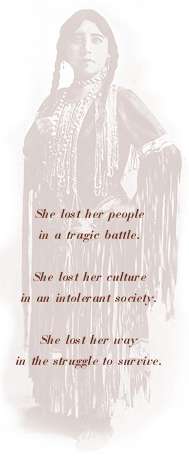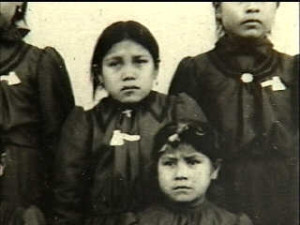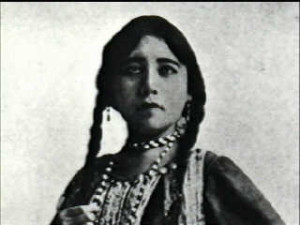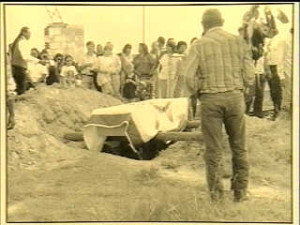 Lost Bird Story Summary
Lost Bird Story Summary
 In the spring or summer of 1890, Lost Bird was born somewhere on the prairies of South Dakota. Fate took her to Wounded Knee Creek on the Pine Ridge Reservation on Dec. 29, 1890.
In the spring or summer of 1890, Lost Bird was born somewhere on the prairies of South Dakota. Fate took her to Wounded Knee Creek on the Pine Ridge Reservation on Dec. 29, 1890.
On that tragic day, hundreds of Lakota men, women and children died in a confrontation with U.S. troops and the woman who likely was the child’s mother was among them. But as she was dying, she and her baby found some scanty shelter from the bitter cold and wind in the bank of a creek.
Four days after the massacre, a rescue party found the infant, miraculously alive, protected by the woman’s frozen body.
The infant was passed from one person to another and her sensational story attracted the attention of powerful white men.  Eventually, this living souvenir of Wounded Knee ended up in the hands of a National Guard general.
Eventually, this living souvenir of Wounded Knee ended up in the hands of a National Guard general.
Lost Bird was adopted by Gen. Leonard Colby and, without her knowledge or consent, his suffragist wife, Clara Bewick Colby. The baby’s original name died on the killing field, along with her chance to grow up in her own culture. She became. literally and figuratively, Zintkala Nuni, the Lost Bird.
So Lost Bird – Zintka, as her adopted mother called her – ended up the daughter of a very socially and historically prominent white couple. She had one big advantage – a mother who came to love her. Though Zintka’s adoption was a surprise to her, Clara Colby took on the duties of motherhood in addition to her work as a suffragette activist, lecturer, publisher and writer.
However, Zintka’s childhood was marred by her exposure to racism, possible abuse from adoptive relatives and the indifference of her father. Poverty entered into the mix when Gen. Colby abandoned his wife for the child’s nursemaid/governess and failed to provide adequate support for Clara Colby and Zintka.
 The increasingly restless child endured miserable stays with relatives and at boarding schools and became harder and harder for her mother to control.
The increasingly restless child endured miserable stays with relatives and at boarding schools and became harder and harder for her mother to control.
At age 17, Zintka was sent back to her father and his new wife in Beatrice, Neb. The result was disastrous. A few months later, Gen. Colby placed his now-pregnant daughter in a stark and severe reformatory. Her son was stillborn, but the girl remained in the facility for a year.
Zintka eventually returned to her mother. At one point, she seemed to have found happiness in marriage, but the relationship disintegrated when she discovered her new husband had given her syphilis, then incurable. She struggled with the effects of that illness for the rest of her life.
She had a number a careers during her short life: work with Buffalo Bill’s Wild West Show, various entertainment and acting jobs, and possibly prostitution. Three times, she managed to visit South Dakota in search of her roots, but her welcome was cool.
By 1916, Zintka was living in abject poverty. She and her then-husband, who suffered from illness, were trying to make a living in vaudeville. She had had two more children. One died, probably that year, and Zintka gave the other to an Indian woman who was better able to care for him. Later that year, she lost her loving mother, Clara Colby, to pneumonia.

Eventually, Zintka and her husband gave up vaudeville and moved in with his parents in Hanford, Calif., in 1918. Zintka fell ill on Feb. 9, 1920, as an influenza epidemic swept across the nation. On Feb. 14, Valentine’s Day, she died.
Clara Colby tried to raise Zintka as a white girl in an unaccepting society and tried to erase her unceasing attraction to her Lakota culture. In the end, Zintka was rejected by both.
Lost Bird finally came home in 1991, in an effort spurred in part by author Renee Sansom Flood, author of “Lost Bird of Wounded Knee: Spirit of the Lakota.” Her grave was found in California and her remains were returned to South Dakota and buried at the grave site at Wounded Knee. Her tragic story led to the organization of the Lost Bird Society, which helps Native Americans who were adopted outside their culture find their roots.

Sources: “Lost Bird of Wounded Knee: Spirit of the Lakota” by Renee Sansom Flood.
Used with permission. for original site click here:
